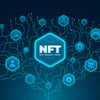The Evolution of Gaming: 3D Models, NFTs, and the Metaverse - Emerging Trends and Creative Insights

Gaming, in one form or another, has been a part of human history for centuries. From ancient board games like Senet to the early electronic games like Pong in the 1970s, gaming has constantly evolved and adapted to the changing times. However, it was the rapid advancements in technology that truly revolutionized the gaming industry and laid the foundation for the modern gaming experiences we enjoy today.
The transition from simple text-based games to graphical interfaces, followed by the advent of 2D and 3D graphics, marked significant milestones in gaming history. Moreover, the rise of the internet and the proliferation of high-speed connectivity have ushered in a new era of online gaming. Multiplayer games, massive open-world environments, and live streaming have become possible due to the interconnectedness of players worldwide. The ever-expanding mobile technology has further democratized gaming, making it accessible to a broader audience.
As technology continues to push boundaries, 3D models, Non-Fungible Tokens (NFTs), and the Metaverse have emerged as revolutionary elements in gaming. 3D models have transformed gaming experiences by bringing unprecedented levels of realism and interactivity. NFTs have introduced the concept of true ownership and scarcity in the digital realm, enabling players to have unique and tradable in-game assets. The Metaverse, a vast interconnected virtual universe, has opened up new possibilities for immersive and social gaming experiences.
I. The Evolution of 3D Models: Transforming Gaming Experiences
The integration of 3D models has revolutionized both visuals and gameplay mechanics. Developers can now create complex environments with interactive physics, realistic object interactions, and seamless level design, resulting in more engaging gameplay and a deeper sense of immersion and agency for players.
Moreover, 3D models have played a pivotal role in interactive storytelling, bringing characters and narratives to life with expressive facial animations and motion capture technologies. Players' interactions with 3D-modeled characters influence branching narratives and choices, leading to personalized storytelling experiences that resonate deeply with players.
Furthermore, the versatility of 3D modeling offers extensive customization options, allowing players to create unique avatars and customize in-game items and environments. This level of personalization strengthens the connection between players and the game world, enhancing player satisfaction and loyalty.
II. Expanding Horizons: The Intersection of 3D Models, NFTs, and Gaming
NFTs have revolutionized ownership in gaming. By tokenizing 3D assets, players gain true ownership of unique in-game items, characters, and properties. They can trade, sell, and showcase these assets in various marketplaces, creating a new gaming economy driven by player ownership.
NFTs also introduce rare and sought-after 3D models, becoming status symbols and marks of gaming achievements. The scarcity of these assets adds value and instills prestige and pride among players who own them.
In addition, augmented reality (AR) and virtual reality (VR) technologies enhance gaming experiences by bridging the gap between real and virtual worlds. AR brings digital content into the physical environment, while VR immerses players fully in virtual worlds, creating endless possibilities for gaming experiences that blend reality and imagination.
III. NFTs in Gaming: The Next Frontier
Non-Fungible Tokens (NFTs) are unique digital assets that represent ownership and provenance on blockchain networks. Unlike cryptocurrencies, NFTs cannot be exchanged on a one-to-one basis since each token has distinct attributes and value. In gaming, NFTs are used to tokenize 3D assets, characters, skins, and other in-game items, granting players true ownership over these digital assets.
a. How NFTs Enhance Gaming Experiences and Ownership
NFTs have revolutionized gaming by introducing true ownership of in-game assets. However, with NFTs, players can freely buy, sell, and trade their virtual possessions in a secure and transparent manner, unlocking a new level of value and investment within the gaming ecosystem.
Moreover, the unique nature of NFTs fosters a sense of scarcity and exclusivity, creating a thriving market for rare and collectible in-game assets. This aspect of NFTs adds a layer of excitement and achievement to the gaming experience, as players aim to acquire unique items and characters that set them apart from others.
b. Gaming Collectibles and Their Impact on the NFT Market
Gaming collectibles have become a significant part of the NFT market, attracting both players and collectors alike. Rare skins, exclusive characters, and limited-edition items have become highly sought-after NFT collectibles, often commanding high values in the marketplace. This trend has not only boosted the popularity of NFTs within the gaming community but also drawn the attention of collectors and investors from outside the gaming world.
IV. The Metaverse: Gaming's New Horizon
The Metaverse is a vast interconnected virtual universe that encompasses multiple virtual worlds, augmented reality spaces, and social platforms. Gaming has been at the forefront of the Metaverse's development, with various online multiplayer games and virtual worlds serving as crucial building blocks of this evolving digital landscape. As gaming continues to embrace the concept of the Metaverse, players can expect even more immersive and interconnected experiences that blur the lines between virtual and real life.
a. The Potential of Virtual Worlds in Gaming
Virtual worlds have long been a staple in gaming, but the advent of the Metaverse takes their potential to new heights. These vast, persistent virtual spaces allow for expansive exploration and social interaction among players, fostering a sense of belonging to a larger community. Virtual worlds provide players with unique opportunities to engage in various activities, from virtual concerts and events to virtual economy and real estate ownership.
b. How the Metaverse Fosters Immersive Experiences
The Metaverse promises to create immersive experiences that transcend the confines of traditional gaming. By integrating various forms of media, such as 3D models, NFTs, AR, and VR technologies, the Metaverse offers a seamless and holistic experience for players. Whether attending a virtual conference, exploring a fantastical virtual world, or participating in virtual art galleries, the Metaverse brings together diverse experiences in an interconnected digital space.

V. Creative Insights in Gaming
Storytelling has always been a fundamental aspect of gaming, and in modern games, interactive storytelling takes center stage. Players are no longer passive observers but active participants in shaping the game's narrative. This level of agency creates a deeper emotional connection between players and in-game characters, making the storytelling experience more engaging and immersive. Game developers are using 3D models and advanced animation techniques to create expressive characters that react to players' decisions.
Gamification involves applying game-like elements, such as rewards, challenges, and progress tracking, to non-gaming contexts. In the gaming industry, this concept has become a powerful tool to enhance player engagement and motivation. By incorporating 3D models and NFT-based rewards, game developers can create a sense of achievement and exclusivity for completing challenges or reaching specific milestones.
VI. The Future of Gaming: Technology and Economy
Play-to-earn gaming models have gained significant momentum in recent years. By leveraging blockchain technology and NFTs, players can earn cryptocurrency or in-game tokens by participating in gameplay, contributing to the game's ecosystem, or owning rare NFT assets. As more games adopt play-to-earn models, the gaming landscape is likely to witness a shift towards more player-centric and economically rewarding experiences.
a. Virtual Economies Within Gaming Ecosystems
Virtual economies are now integral to modern gaming. In games with in-game currencies and marketplaces, players can trade virtual assets. NFTs have strengthened virtual ownership, enabling the exchange of unique items with real-world value.
3D models are vital to these virtual economies, allowing developers to create visually stunning assets. Limited-edition 3D models and rare virtual objects enhance the value and exclusivity of in-game possessions.
b. Gaming Platforms of the Future: Cross-Platform Integration
Cross-platform integration reshapes gaming, enabling seamless access across devices. Whether on a console, PC, or mobile, players enjoy continuous progress and interactions in the same virtual world and community.
3D models ensure consistency and visual fidelity across platforms, creating a cohesive and immersive gaming experience. With cross-platform gaming on the rise, a more interconnected and socially vibrant gaming ecosystem awaits players.
VII. Gaming Community and Social Impact
Live streaming has revolutionized how games are experienced and shared. By showcasing gameplay experiences in high-quality 3D visuals, live streamers can provide viewers with an immersive and captivating perspective of the gaming world. This form of content sharing not only entertains but also informs and inspires players, shaping trends and influencing gaming culture.
a. How Gaming Communities Influence Game Development
Gaming communities impact game development. Developers engage with players through forums, social media, and feedback sessions to gather insights for updates, balance adjustments, and new features. Using 3D models in community engagement, developers share sneak peeks, receive visual feedback, and build anticipation. This involvement fosters a shared sense of ownership and loyalty among players.
b. The Social Impact of Gaming and Fostering Positive Communities
Gaming is now a social and inclusive space, fostering a sense of belonging for players of all backgrounds. Online multiplayer games and virtual worlds enable connections, collaborations, and meaningful relationships, often extending beyond the virtual realm.
Embracing diversity in character design and inclusive gaming experiences promotes positive representations and a welcoming gaming community. 3D models play a crucial role in creating diverse and relatable characters that resonate with players from various cultures, fostering inclusivity and empathy within the gaming world.
VIII. Mobile Gaming Trends and Innovations
Mobile gaming has exponentially grown in the past decade, becoming a dominant segment in the industry. Smartphones and high-speed internet have made gaming accessible to billions worldwide. The convenience and portability of mobile devices led to a surge in downloads and active users, making it lucrative for developers.
The integration of 3D models in mobile games elevates visual quality and immersion. Advancements in mobile hardware enable stunning 3D environments and characters, offering console-like experiences on the go.
a. The Impact of Mobile Gaming on the Gaming Industry
The rise of mobile gaming profoundly impacts the gaming industry. Traditional companies now develop mobile games to reach wider audiences, blurring the lines between console, PC, and mobile gaming. Mobile gaming's success influences game design, prioritizing intuitive touch controls, engaging gameplay, and social integration for a broader audience. Mobile gaming trends often lead innovation and player engagement across all gaming platforms.
b. The Intersection of Mobile Gaming and Emerging Technologies
Mobile gaming tests emerging technologies reshaping the gaming landscape. AR integration, like Pokémon GO, blends real and virtual worlds, enabling interaction with virtual objects in physical surroundings for enhanced immersion.
Additionally, mobile gaming embraces play-to-earn models and NFTs, allowing players to earn rewards and monetize virtual assets securely through blockchain technology. The fusion of mobile gaming with 3D models, NFTs, and the Metaverse creates new possibilities for a connected and immersive gaming experience across all platforms.

IX. Conclusion
The future of gaming holds immense promise with 3D models, NFTs, and the Metaverse. These innovations redefine ownership and player engagement, elevating visuals and introducing true value to in-game assets. The interconnected virtual universe of the Metaverse will revolutionize social interaction and collaborative gaming. Innovation remains vital for the gaming industry's growth. Advancing technology, like 3D models, blockchain, AR, and VR, will lead to transformative gaming experiences, blurring the lines between reality and imagination.
As the gaming industry evolves, my3dmodels.com shapes the landscape with high-quality 3D assets. Their contributions create stunning and engaging gaming experiences. Involvement in the NFT marketplace empowers players to own and trade unique in-game assets, enhancing the gaming experience. 3D models, NFTs, and emerging technologies transform gaming, offering immersion, ownership, and social connectivity. Innovation remains a driving force, and with my3dmodels.com's cutting-edge assets, the gaming industry reaches new heights of creativity and player engagement.
-
Posted in
3d model, 3d NFT, game development, METAVERSE




